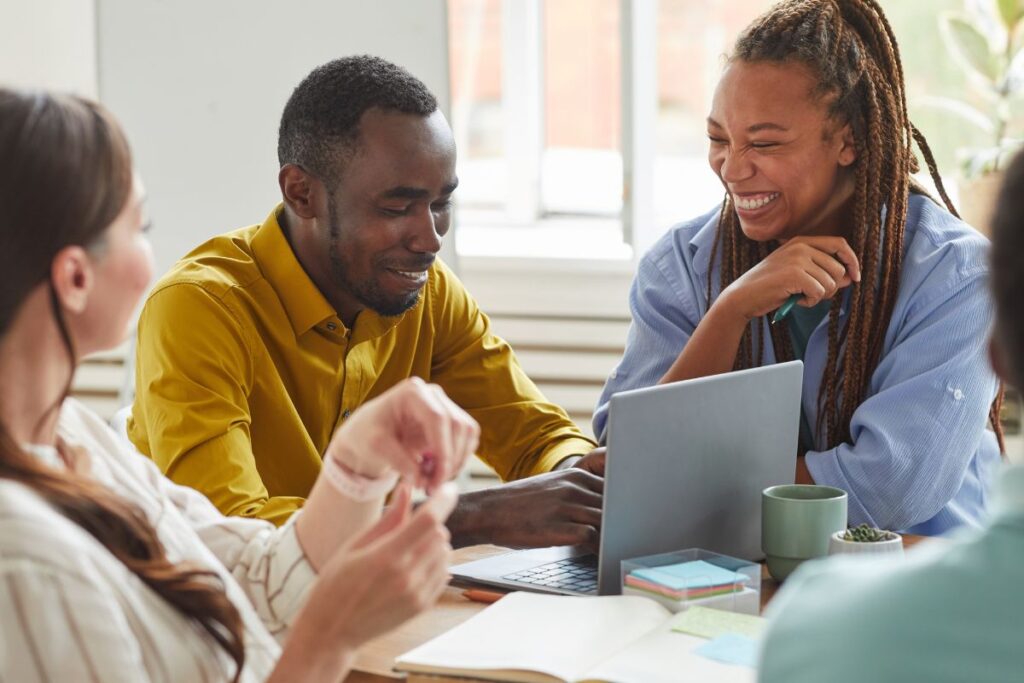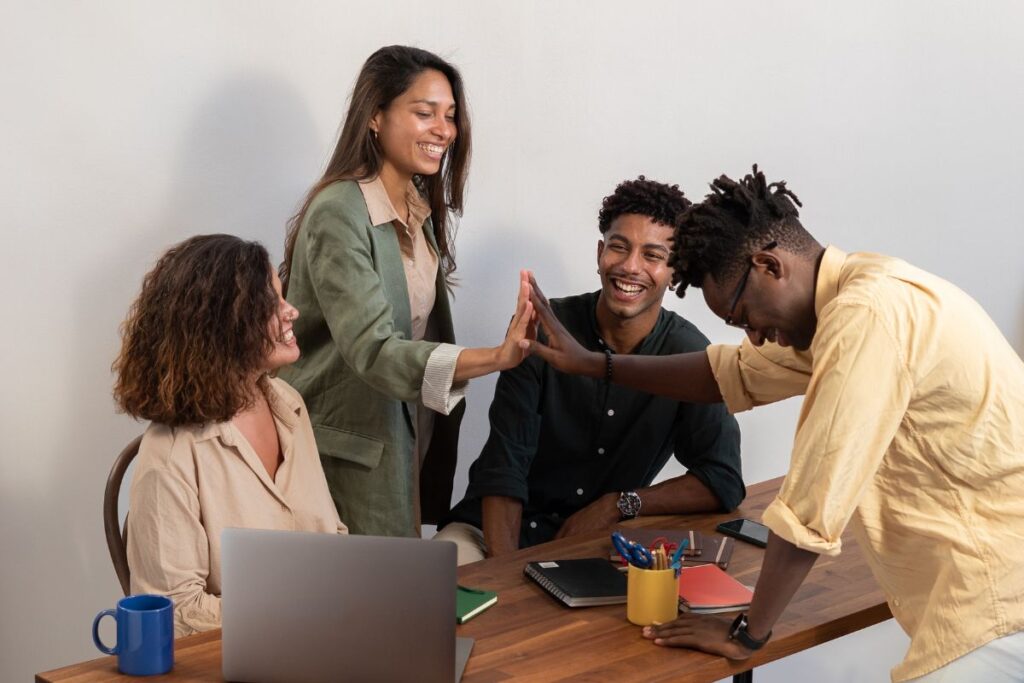👇Want To Engage Your Employees in Ways That Matter Most?👇
🎁 Celebrate Progress, Uniquely
Inclusive, personalised, and genuinely thoughtful – move beyond generic merch with gifts that reflect the value of every individual.
🚀 Support Engagement, Learning & Belonging
From onboarding to professional development, recognise milestones in a way that empowers neurodiverse talent and reinforces inclusion.
🌈 Ethical, Considerate & People-First
Champion neurodiversity through meaningful gifts that support local makers, give back to social causes, and create a culture where everyone feels seen and supported.

Neurodiversity at Work: How to Build a More Inclusive Workplace
The way we work has changed and so have the conversations we need to be having. Over the past few years, we’ve all become more comfortable talking about mental health, flexibility, inclusion and belonging. But one important area is still missing from many workplace conversations: neurodiversity.
Neurodiversity is all about recognising that not everyone thinks, communicates, or processes the world in the same way and that’s not only okay, it’s valuable. It means making space for the different ways our minds work and understanding that there’s no “one size fits all” approach to being productive, creative or collaborative at work.
Around 20% of people are believed to be neurodivergent – meaning they experience the world differently in ways that can include ADHD, autism, dyslexia, dyspraxia and more. These are people already working in your teams, joining your meetings, and delivering results. The question is, are we creating spaces where they feel seen, understood and supported?
We believe that when it comes to building great teams and human-first cultures, inclusion must include neurodiversity. It’s time to shift the conversation and rethink what support, recognition and connection really look like at work.

Understanding Neurodivergence: Brains Work Differently
When we talk about neurodivergence, we’re talking about how people experience and interpret the world in ways that don’t always align with traditional expectations. This might be through how someone focuses, communicates, solves problems, or responds to their environment. It’s a term that includes a range of different ways of thinking, such as ADHD, autism, dyslexia, dyspraxia, Tourette’s and more.
But here’s what’s important: these are not labels that tell the full story. Just as no two people are the same, no two neurodivergent people will share identical needs, challenges or strengths. Some individuals might find it hard to manage time or process written information, while others might have incredible attention to detail or creative insight that others miss.
It’s also common for someone to experience more than one type of neurodivergence, sometimes called co-occurring conditions, which adds another layer to how they show up at work and what support might be useful for them.
This is why we should never make assumptions. Neurodivergence is a reminder that brains work differently, and our working environments should reflect that. When we start designing teams, communication, and culture with that in mind, we create workplaces where people don’t just fit in, they flourish.
3. Moving from Awareness to Action
Knowing that neurodivergent people are part of every workplace is a great starting point but real inclusion happens when we move beyond awareness and into action.
That begins with how we talk about neurodiversity. Conversations don’t need to be perfect, but they do need to happen. When we speak openly whether that’s during onboarding, in team check-ins, or as part of wellbeing initiatives, we create a culture where people feel safe to share how they work best, and what might help them thrive.
One of the challenges many neurodivergent employees face is masking, the effort of hiding or downplaying traits to blend in or meet expectations. This might look like forcing eye contact, holding back stimming behaviours, or mimicking social cues. While masking can sometimes help people feel accepted, it often comes at a cost: exhaustion, anxiety, and a feeling of not being able to show up as themselves.
That’s why everyday inclusivity matters. Something as simple as asking, “What’s the best way for us to work together?” can open the door to more honest, human conversations.
It’s also worth noting that language preferences vary. Many people use identity-first language (e.g. “autistic person”) because it reflects pride and ownership of who they are. Others might prefer person-first terms, like “a person with autism.” There’s no one-size-fits-all rule, just a reminder to lead with empathy and let individuals set the tone for how they’re described.
Neurodiversity awareness is about seeing difference as something to embrace, not fix, and backing that up with action that makes it easier for everyone to be themselves at work.

4. The Business Case for Neuro-inclusion
Creating a more inclusive workplace for different types of thinkers isn’t just a moral move, it’s a strategic one. The value of neurodiversity in the workplace stretches across innovation, wellbeing, culture, and business performance.
Here’s how that plays out:
💡 Innovation and Better Thinking
- Diverse minds bring diverse solutions.
Neurodivergent employees often approach tasks from unconventional angles, seeing patterns and possibilities that others might miss. This creates more robust problem-solving and a team that’s naturally equipped to think outside the box. - Variety drives agility and creativity.
When everyone doesn’t think the same, you avoid groupthink, and you open the door to more creative, future-focused ideas. In fast-paced industries, having a team that can adapt and ideate differently is a genuine competitive edge.
😊 Happier, More Engaged People
- Support = satisfaction.
When people are allowed to work in a way that suits how their brain operates, whether that’s through flexible hours, fewer meetings, or different communication styles, they feel respected. And when people feel respected, they stay. - Inclusion boosts performance.
Neuro-inclusive workplaces help individuals feel safe to be themselves. That sense of belonging leads to higher engagement, better wellbeing, and stronger collaboration across teams.
🔍 Unlocking Overlooked Talent
- Many traditional hiring methods filter out neurodivergent talent.
Job descriptions packed with jargon, or interviews focused on eye contact and small talk, can easily screen out brilliant candidates who simply think and communicate differently. - Neurodivergent professionals bring powerful strengths.
From laser-like focus to deep technical expertise, or the ability to spot patterns others miss, these are the kind of talents that don’t always show up in a CV or interview but can transform a team once they’re in the room. - Rethinking how you hire is a growth lever.
Organisations that review their hiring and onboarding processes with neuro-inclusion in mind aren’t lowering the bar, they’re finally opening the door to more capability, innovation, and potential.
📊 The Data Speaks for Itself
Closing that gap is a business advantage.
For companies willing to lead the way, embedding neuro-inclusion into your culture and strategy isn’t just good ethics. It’s good business, one that builds teams that are more resilient, more diverse in thought, and more reflective of the world we live in.
Most organisations want to be inclusive – but aren’t acting on it.
According to CIPD’s Neuroinclusion at Work Report, 60% of organisations say neuroinclusion is a top priority for them. But if we want truly inclusive workplaces, we need to stop seeing neurodiversity as something niche, and start seeing it as a core part of building better, more human businesses.

5. Barriers Faced by Neurodivergent Employees
Even in well-meaning workplaces, many neurodivergent employees still face hurdles that others may not see. These challenges can affect everything from comfort to performance, and most of them are caused by how work is structured, not by the individual.
Here are some of the most common barriers:
🧠 Environmental challenges
- Bright lights, loud spaces or strong smells can cause sensory overwhelm
- Open-plan offices often make focus and regulation harder
- Back-to-back meetings with no downtime can lead to burnout
📋 Exclusion by design
- Vague or overly complex job descriptions can put off highly capable candidates
- Hiring processes often reward social ease rather than actual job skills
- Standard “one-size-fits-all” onboarding or training doesn’t work for every brain
🧍♀️ Lack of psychological safety
- Fear of being judged stops people from asking for help or adjustments
- “Masking” (hiding traits to blend in) is exhausting and affects mental health
- Few opportunities to give feedback about what’s not working
🚧 What’s really behind these barriers?
Much of it comes down to how workplaces are built. Traditional systems often assume that everyone thinks, communicates and processes the same way which simply isn’t true.
Instead of focusing on what someone can’t do, the social model of disability asks a better question:
“What in the environment is getting in the way and how can we change it?”
🌱 So, what does an inclusive workplace look like?
- Flexible workspaces and routines
- Clear, straightforward communication
- Space for people to ask for what they need, without fear
- A culture where difference is normal, not ‘other’
Removing barriers doesn’t mean lowering standards, it means raising inclusion. When we get this right, everyone benefits.

6. What a Neuro-inclusive Organisation Looks Like
Creating a neuro-inclusive culture is about designing a workplace where everyone can do their best work, in ways that genuinely work for them. And while every team is different, there are a few key traits that inclusive organisations have in common.
Here’s what it looks like in action:
🔄 Flexible Working That Actually Works
- One-size-fits-all doesn’t fit most people, especially not neurodivergent ones.
Flexible working is one of the most powerful tools we have. Whether it’s adjusting start times, working remotely, or offering quiet spaces in the office, flexibility gives people the breathing room to manage their focus, energy and mental wellbeing in a way that suits them. - For neurodivergent people, flexibility is often essential.
The freedom to structure a day to suit your thinking style or reduce sensory overload can be the difference between just getting through the day and actually thriving in your role.
💬 Clear, Simple Communication
- Being clear is inclusive.
Direct, jargon-free communication benefits everyone, but it’s especially important for people who process information differently. Neuro-inclusive teams are mindful of how they brief, instruct, and provide feedback. - Don’t assume understanding, create it.
Whether it’s writing meeting follow-ups, giving task instructions in multiple formats, or asking how someone prefers to receive feedback, great communication is about listening as much as talking.
🛠 Personalised Support and Adjustments
- No two brains are the same and support shouldn’t be either.
Some people may need noise-cancelling headphones. Others might benefit from visual planning tools, flexible deadlines, or fewer in-person meetings. The key is to have conversations that are tailored, respectful and proactive. - Adjustments aren’t about lowering expectations, they’re about unlocking performance.
When people get what they need, they can contribute more confidently and consistently. That’s the kind of support that fuels real impact.
🎓 Awareness Training That Sparks Real Change
- People can’t support what they don’t understand.
Training helps build empathy, bust myths, and equip teams with the tools to create a more inclusive environment. It also gives managers the confidence to have better, more sensitive conversations with their teams. - This isn’t about getting it perfect, it’s about being open.
Training helps people learn how to ask, listen and respond without fear of saying the “wrong thing.” That openness is key to building a workplace where neurodivergent people feel genuinely welcome.
🛤 It’s a Journey, Not a Tick Box
- Being inclusive isn’t something you finish.
Building a neuro-inclusive organisation is ongoing. It requires reflection, feedback and the willingness to keep learning, and sometimes unlearning, how things are done. - Start small, but stay committed.
Even small changes, like adjusting how you run meetings or how roles are advertised, can make a huge difference. The point is to keep moving forward, together.
🌟 In practice:
A neuro-inclusive organisation values difference, listens openly, and adapts with intention. It’s not perfect, but it’s real, human and evolving.
And that’s what makes it work.

7. Inclusive Hiring Practices
Inclusive hiring starts long before someone joins your team. If we want to build workplaces that truly welcome neurodivergent talent, we need to take a close look at how we recruit, from the language in job ads to how interviews are run.
Here’s how to make your recruitment process more neuro-inclusive – and more human, for everyone:
📝 Write Accessible, Straightforward Job Ads
- Clarity is kindness.
Job descriptions packed with vague terms like “excellent communication skills” or “team player” can be confusing – especially for candidates who are more literal or who communicate differently. Focus on the actual skills and outcomes the role requires. - Avoid jargon and fluff.
Keep descriptions clear, concise and free from internal language that assumes prior knowledge. This improves accessibility in hiring not just for neurodivergent applicants, but for anyone new to your industry or career level.
📩 Share Interview Questions in Advance
- This isn’t about giving answers away, it’s about creating equal footing.
Letting candidates know what to expect reduces anxiety and gives them time to prepare their best responses. It also helps level the playing field for people who process information differently. - Structured interviews make better hires.
Even neurotypical candidates often perform better when they’re given time to think – which is why this approach isn’t just inclusive, it’s good practice all around.
🛠 Offer Alternative Interview Formats
- Standard interviews aren’t always the best measure of ability.
Some brilliant thinkers might not shine in a traditional interview – but would thrive in a work trial, task-based assessment, or informal project brief. - Think about how you assess what matters most.
Is eye contact really a predictor of job performance? If not, it’s time to remove it as a silent benchmark. The goal is to understand how someone works, not just how they interview.
🌍 Good Practice for Everyone
- These aren’t “special accommodations”, they’re just better hiring practices.
Everything listed here improves your recruitment experience for all candidates. Clearer job ads attract better applicants. Less stressful interviews create more thoughtful conversations. More accessible processes bring in more diverse voices. - Inclusive recruitment = stronger teams.
When you make your hiring process accessible to more types of thinkers, you’re not lowering the bar – you’re opening the door to more talent, perspective, and potential.
✨ In summary:
Neurodiversity hiring isn’t about rewriting your values, it’s about aligning your actions with them. And it all starts with rethinking the candidate experience, from the very first step.

8. Supporting Career Progression
Being inclusive doesn’t stop at hiring. If we want to build truly equitable workplaces, we also need to think about what happens after someone joins the team. That means ensuring neurodivergent employees aren’t left behind when it comes to career progression and opportunities to lead, grow, or specialise.
Here’s how inclusive leadership can support every kind of career journey:
🚀 Don’t Let Neurodivergent Talent Be Overlooked
- Talent doesn’t always look like we expect.
Neurodivergent employees might not self-promote, volunteer for stretch projects, or fit the traditional “leadership mould.” But that doesn’t mean they’re not ready for more. Bias even unconscious – can play a big role in who gets tapped for promotions or high-profile work. - Check your criteria.
Are your promotion decisions based on who speaks up the most in meetings, or who delivers consistent, high-quality results? Reassessing what “leadership potential” looks like is key to supporting neurodivergent careers.
🛤 Create Alternative Progression Paths for Specialists
- Not everyone wants to manage people and that’s okay.
Some neurodivergent professionals thrive in deep, technical or creative roles where they can go further into their craft rather than stepping into line management. A lack of non-managerial growth paths can stall careers unnecessarily. - Design career ladders, not just climbing frames.
Offer clear ways for people to progress as individual contributors, whether that’s through title changes, increased autonomy, mentorship roles, or expert recognition. This is part of meaningful, long-term career support.
💬 Normalise Honest Conversations About Growth
- Ask, don’t assume.
An open “Where do you want to go next?” conversation can go a long way. Some neurodivergent employees might hesitate to raise aspirations for fear of being misunderstood, or judged by past challenges. Managers can break that silence with curiosity and care. - Make development part of regular check-ins.
Rather than saving big conversations for annual reviews, build career development into everyday coaching. That way, goals stay visible and employees feel seen, not side-lined.
🌱 In practice:
Supporting neurodivergent careers is about flexibility, fairness and visibility. When inclusive leadership builds clear, diverse paths to progression, and creates space for everyone to talk openly about their goals, the whole organisation moves forward.

9. How Every Role Can Contribute
Creating a truly inclusive workplace isn’t the job of one person or department, it’s something we all play a part in. From senior leaders to new starters, everyone has the power to help build a culture that supports different thinking styles and celebrates difference.
Here’s how each role can make a meaningful impact:
👩💼 Managers: Lead with Curiosity and Care
- Good management is human management.
Managers are often the first line of support, and their actions set the tone for what’s accepted, encouraged, and respected in a team. Practising neuro-inclusive leadership means taking the time to understand individual working styles, offering flexibility where possible, and proactively asking how you can support each person to thrive. - Don’t wait for someone to disclose.
Not every neurodivergent employee will feel comfortable sharing, or even know they’re neurodivergent. That’s why it’s essential to build supportive practices into how you work with everyone, not just those who ask.
🧑💻 HR and People Teams: Build Systems That Work for All Brains
- Inclusion needs structure.
From hiring to progression and performance reviews, people policies should be reviewed through a neuro-inclusive lens. Are they flexible? Are adjustments easy to request? Do your systems encourage or hinder psychological safety? - Offer practical tools and ongoing support.
Provide templates, resources and neurodiversity training to help managers feel confident in these conversations, and give employees clear routes to get what they need.
🧑⚖️ Senior Leaders: Set the Cultural Standard
- Culture is led from the top.
When leaders champion neuro-inclusion whether that’s by speaking up, sharing personal experiences, or visibly supporting initiatives, it gives permission for others to care, too. - Model openness, not perfection.
You don’t have to be an expert. You just have to be willing to listen, learn, and lead with empathy. That’s how trust is built, and that’s how lasting change happens.
🤝 Everyone: Be Part of the Culture Shift
- Inclusion is a team sport.
Colleagues can play a huge role in creating comfort and connection. That might look like adjusting how you collaborate, supporting quiet working time, or simply being thoughtful in how you communicate. - Empathy over assumption.
Rather than guessing what someone needs or judging how they work, start with curiosity. Ask how you can support. Listen. And remember that different doesn’t mean difficult – it just means different.
🎓 Why Training and Everyday Conversations Matter
- Neurodiversity training builds understanding but everyday actions build trust.
The more we talk about adjustments, working styles and communication preferences as part of everyday work, the less ‘different’ they feel. Over time, that’s what creates psychological safety at work.
💬 In summary:
In a neuro-inclusive workplace, everyone plays a role.
Not just in supporting individuals, but in reshaping what it means to belong, to lead, and to thrive.

Neuro-inclusion Is the Future of Work
We’re long past the point where inclusion can be treated as a buzzword. For businesses that want to grow, retain great people and truly reflect the diverse world we live in, embracing neurodiversity at work is essential.
From recruitment to career progression, team culture to leadership, every part of the employee experience can either empower or exclude. That’s why building a neuro-inclusive workplace isn’t about grand gestures, it’s about everyday moments of flexibility, understanding, and human-first thinking.
Whether you’re just starting the conversation or already making changes, remember: this is a journey. And every step you take to include and support different thinkers makes your business stronger, your culture richer, and your people more connected.
We believe that meaningful work starts with meaningful connection, and that inclusion should be felt, not just promised. Because when people feel seen, supported and celebrated for who they are, that’s when they really shine.

